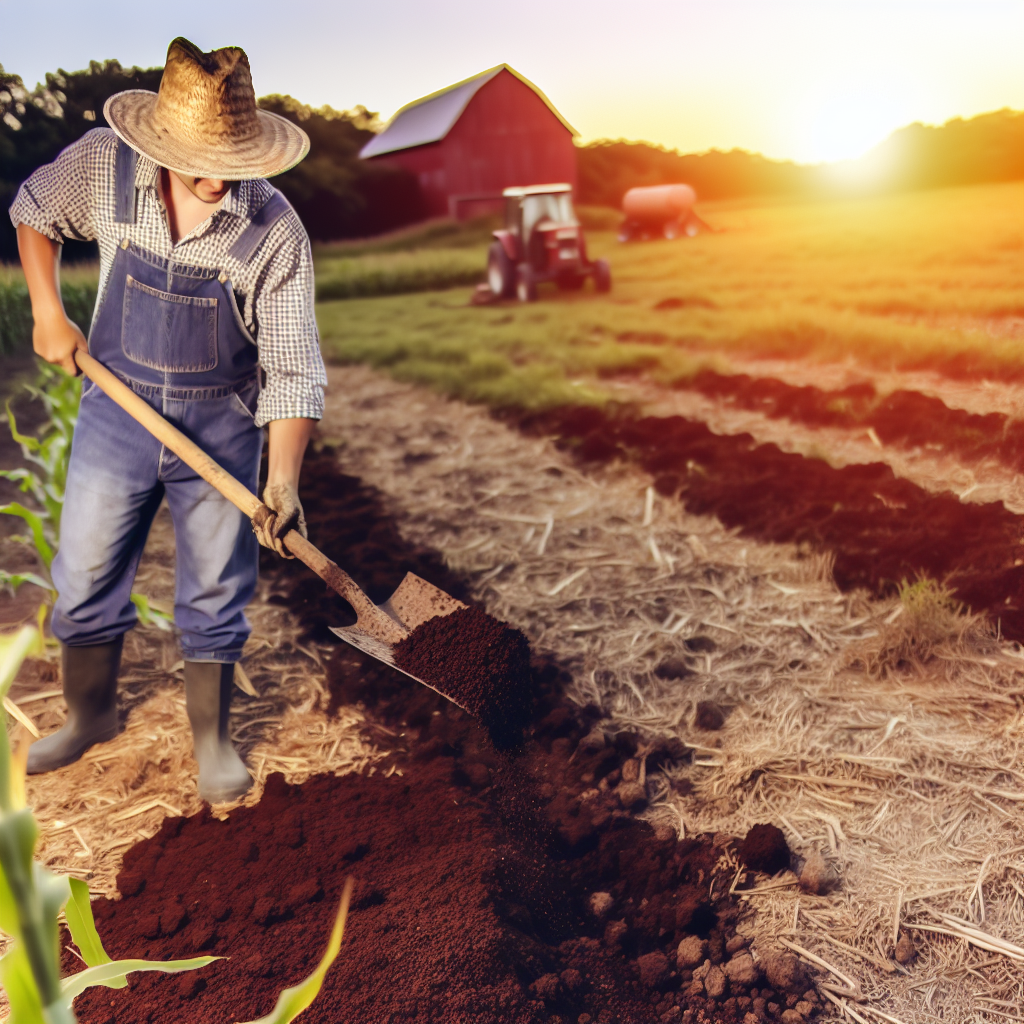Introduction to Biochar and Its Role in Agriculture
Biochar is a charcoal-like substance created through the pyrolysis of biomass.
This process involves heating organic material in a low-oxygen environment.
Farmers increasingly utilize biochar to improve soil fertility.
It enhances soil structure, nutrient retention, and moisture retention.
Furthermore, biochar can sequester carbon, helping mitigate climate change.
Understanding Biochar Composition
Biochar consists mainly of carbon, but it also contains essential nutrients.
Common elements include nitrogen, phosphorus, and potassium.
Its porous structure promotes microbial activity in the soil.
This active microbial community aids in nutrient cycling.
Moreover, biochar can absorb pollutants, improving soil health.
Applications of Biochar in Agriculture
Farmers apply biochar to various cropping systems worldwide.
It is suitable for both conventional and organic farming practices.
Some growers mix biochar directly into the soil.
Others utilize it as a top dressing around plants.
Ultimately, it enhances both crop yield and quality.
Transform Your Agribusiness
Unlock your farm's potential with expert advice tailored to your needs. Get actionable steps that drive real results.
Get StartedBenefits of Using Biochar
Using biochar offers several advantages for soil fertility.
- It increases nutrient retention in the soil.
- Biochar improves water retention, reducing irrigation needs.
- It enhances soil structure, promoting root development.
- There is a reduction in greenhouse gas emissions from soils.
- Biochar can stimulate beneficial microbial populations.
Challenges and Considerations
Despite its benefits, challenges exist when using biochar.
The quality of biochar varies based on production methods.
Additionally, there is a need for proper application rates.
Farmers should consider their specific soil types and crops.
Another consideration is the potential for nutrient lock-up.
To mitigate this, it is essential to conduct soil tests before application.
Recent Research and Innovations
Current research continues to explore new biochar applications.
Studies show its potential in carbon farming initiatives.
Innovations in biochar production techniques are emerging.
These advances aim to enhance biochar’s effectiveness in agriculture.
Researchers also evaluate its impacts on different soil types.
Historical Context and Traditional Uses of Biochar in Soil Management
Origins of Biochar
Biochar has ancient roots, mainly linked to indigenous practices in the Amazon.
These cultures created biochar to enhance soil fertility.
They used it as a means of waste management, converting biomass into valuable soil amendments.
Significance in Ancient Agriculture
The use of biochar transformed agricultural productivity in pre-Columbian societies.
It allowed for sustainable farming practices that sustained large populations.
Biochar contributed to the creation of Terra Preta, fertile dark soil still found in the Amazon basin.
Modern Recognition of Traditional Practices
Recent research has revived interest in traditional biochar applications.
Scientists recognize its benefits for carbon sequestration and soil health.
This resurgence reflects a growing understanding of sustainable agriculture’s importance.
Various Applications in Soil Management
Traditional cultures utilized biochar in multiple ways to enhance soil quality.
- They integrated biochar with compost to improve nutrient content.
- It served as a habitat for beneficial soil microbes.
- Farmers employed it to increase soil aeration and drainage.
Each application showcased biochar’s versatility and effectiveness.
Impact on Soil Characteristics
Biochar improves soil structure and promotes water retention.
Showcase Your Farming Business
Publish your professional farming services profile on our blog for a one-time fee of $200 and reach a dedicated audience of farmers and agribusiness owners.
Publish Your ProfileIt enhances soil pH balance, benefiting plant growth.
Moreover, biochar aids in nutrient retention, making them available for crops.
Lessons from Traditional Uses
Modern agriculture can learn valuable lessons from ancient biochar practices.
There is an opportunity to incorporate biochar for improved soil management.
Applying these traditional methods can result in healthier, more fertile soils today.
The Process of Creating Biochar: Methods and Techniques
Overview of Biochar Production
Biochar production involves converting organic material into charcoal-like substance.
This process improves soil fertility and carbon storage.
Understanding the methods used to create biochar is essential for maximizing its benefits.
Pyrolysis Method
Pyrolysis is a commonly used technique for producing biochar.
It involves heating biomass in a low-oxygen environment.
This lack of oxygen prevents complete combustion.
Consequently, the organic material breaks down into biochar, gases, and oils.
Gasification Process
Gasification differs from pyrolysis in its method and end products.
This technique converts carbon-rich materials into syngas.
Although primarily for energy, gasification also produces biochar as a byproduct.
As a result, this process can serve dual purposes.
Comparing Methods
Different methods influence the properties of the resulting biochar.
Pyrolysis generally produces a higher-quality biochar.
In contrast, gasification yields biochar with varying characteristics.
Choosing the right method depends on desired biochar properties and intended applications.
Feedstock Selection
Feedstock selection plays a crucial role in biochar production.
Common feedstocks include wood, agricultural residues, and manure.
The choice of feedstock affects biochar’s chemical and physical properties.
Temperature Effects
The production temperature significantly influences biochar quality.
Higher temperatures typically result in more stable biochar.
Conversely, lower temperatures create biochar with higher volatile content.
Final Products and Applications
After production, biochar can be processed further for various applications.
Farmers can incorporate it into soil to enhance fertility.
Additionally, it can be used for carbon sequestration and water filtration.
Thus, the methods of creating biochar are pivotal in determining its effectiveness in these applications.
Learn More: Integrating Crop Diversity into Your Farming Practices
Chemical Composition of Biochar and Its Effect on Soil Health
Understanding Biochar’s Composition
Biochar consists primarily of carbon, hydrogen, and oxygen.
This unique structure forms when organic materials are subjected to pyrolysis.
Besides these elements, biochar may contain various nutrients.
For example, it can include potassium, phosphorus, and calcium.
These innate nutrients contribute to its effectiveness as a soil amendment.
Enhancing Soil Fertility
Biochar enhances soil fertility in several ways.
Firstly, it improves soil structure and aeration.
Well-structured soil retains moisture and allows better root development.
Secondly, biochar increases cation exchange capacity (CEC).
Showcase Your Farming Business
Publish your professional farming services profile on our blog for a one-time fee of $200 and reach a dedicated audience of farmers and agribusiness owners.
Publish Your ProfileThis exchange enhances nutrient retention in the soil.
Impact on Soil Microbial Activity
Biochar also positively affects soil microbial communities.
It provides a habitat for beneficial microorganisms.
These microorganisms play a crucial role in nutrient cycling.
Moreover, an increase in microbial activity boosts soil health.
Carbon Sequestration Benefits
Another significant advantage of biochar is carbon sequestration.
It stores carbon in the soil for extended periods.
This process helps mitigate climate change effects.
Thus, incorporating biochar into soil can serve dual purposes.
It enhances fertility while also promoting environmental sustainability.
Utilization of Biochar in Agriculture
Farmers can utilize biochar to optimize their land.
They can apply it directly to fields, improving crop yields.
Additionally, biochar can suppress certain soil-borne diseases.
This suppression helps maintain healthy plant growth over time.
See Related Content: Sustainable Farm Pathways And Access Planning Essentials
Mechanisms by Which Biochar Enhances Soil Fertility
Improving Soil Structure
Biochar improves soil structure significantly.
It enhances soil porosity and promotes aeration.
Consequently, roots can grow deeper and more efficiently.
Moreover, better structure helps retain moisture.
Enhancing Nutrient Retention
Biochar enhances nutrient retention in the soil.
This phenomenon occurs through its high surface area.
Additionally, biochar’s negatively charged structure attracts cations.
As a result, essential nutrients remain available to plants.
Increasing Microbial Activity
Biochar fosters a thriving microbial community.
Microbes find refuge within its porous structure.
This habitat increases microbial abundance and diversity.
Healthy microbes promote nutrient cycling and decomposition.
Reducing Soil Acidity
Biochar contributes to lowering soil acidity.
It contains alkaline minerals that neutralize excess acidity.
This adjustment benefits crops sensitive to pH levels.
Thus, crops can absorb nutrients more effectively.
Sequestering Carbon
Biochar acts as a stable form of carbon sequestration.
This process helps mitigate climate change impacts.
Additionally, it improves overall soil fertility long-term.
Consequently, biochar serves as an ecological solution.
Improving Water Retention
Biochar increases the water-holding capacity of soils.
Its porous nature allows it to capture and retain moisture.
Therefore, crops benefit from improved water availability.
This ability is especially crucial during dry periods.
Uncover the Details: Enhancing Crop Yields Through Biodiversity
Showcase Your Farming Business
Publish your professional farming services profile on our blog for a one-time fee of $200 and reach a dedicated audience of farmers and agribusiness owners.
Publish Your Profile
Case Studies: Successful Applications of Biochar in Various Agriculture Settings
Agriculture in Brazil
Farmers in Brazil have effectively used biochar to improve soil health.
This application increased crop yields for maize and soybeans substantially.
Farmers observed better water retention in arid regions.
Furthermore, biochar reduced the need for chemical fertilizers.
Research in Australia
Researchers at the University of Queensland studied biochar’s effects on wheat production.
The experiment showed significant increases in nitrogen retention in the soil.
As a result, this led to enhanced plant growth and improved yields.
Community Project in India
A rural community in India implemented biochar as part of their sustainable agriculture strategy.
They created biochar from agricultural waste materials.
This project resulted in healthier crops and increased food security.
Moreover, the community reported better soil fertility and moisture retention.
Commercial Use in the United States
A California farm adopted biochar to enhance vineyard health.
The vineyard’s soil quality improved significantly after application.
This change led to better grape quality and higher market prices.
Additionally, the farm noticed a reduction in irrigation needs.
Innovative Practices in Africa
Farmers in Kenya experimented with biochar to combat soil degradation.
The practice improved soil structure and fertility in degraded lands.
Consequently, they achieved higher yields of staple crops like maize.
Farmers reported enhanced resilience to climate variability.
Learn More: Conservation Tillage Practices to Preserve Soil Moisture
Challenges and Limitations of Biochar Use in Soil Improvement
Understanding the Variability of Biochar Quality
Biochar quality varies significantly depending on production methods.
This variability affects its properties, such as pH and nutrient content.
Consequently, farmers may face challenges in predicting its impact on soil.
Environmental Concerns
The production of biochar can generate emissions, impacting air quality.
These emissions may contribute to climate change if not properly managed.
Moreover, sourcing biomass for biochar might lead to deforestation.
Soil Application Challenges
Applying biochar uniformly can be difficult in large agricultural fields.
Inadequate mixing with soil can result in uneven nutrient distribution.
This unevenness might hinder the anticipated benefits of biochar.
Economic Considerations
Cost is a significant barrier to the widespread adoption of biochar.
Initial investments in biochar production and application can be high.
Further, the lack of government subsidies may deter farmers from utilizing it.
Limited Research and Knowledge
Research on biochar’s long-term effects is still in its infancy.
Many farmers lack access to reliable information about its benefits.
Consequently, misconceptions can discourage its use in agricultural practices.
Crop-Specific Responses
Crops may respond differently to biochar amendments.
Some crops may show minimal growth benefits from biochar application.
This variability complicates farmers’ decision-making regarding its use.
Future Research Directions and Innovations in Biochar Technology
Enhancing Biochar Production Techniques
Future research will focus on improving biochar production methods.
Innovations in pyrolysis technology could increase efficiency and reduce costs.
Showcase Your Farming Business
Publish your professional farming services profile on our blog for a one-time fee of $200 and reach a dedicated audience of farmers and agribusiness owners.
Publish Your ProfileMoreover, researchers aim to develop processes that utilize diverse biomass sources.
Evaluating Soil and Crop Responses
It is essential to study how different soils react to biochar applications.
Additionally, examining various crop species will inform best practices.
Longitudinal studies can provide insights into the long-term benefits of biochar.
Integrating Biochar with Other Sustainable Practices
Integrating biochar with organic farming methods can enhance soil health.
Researchers will assess its compatibility with cover cropping practices.
Additionally, exploring its effect alongside composting will reveal synergies.
Innovations in Biochar Characterization
Advanced analytical techniques will improve biochar characterization methods.
This will help in understanding the unique properties of various biochars.
Furthermore, characterizing biochar’s impact on soil microbiomes is crucial.
Public Awareness and Stakeholder Engagement
Increased public awareness about biochar’s benefits is vital for adoption.
Engaging farmers in research projects can lead to practical feedback.
Partnerships between academia and industry will strengthen knowledge exchange.
Additional Resources
Biochar application for sustainable soil erosion control: a … – Frontiers
Biochar implications for sustainable agriculture and environment: A …




